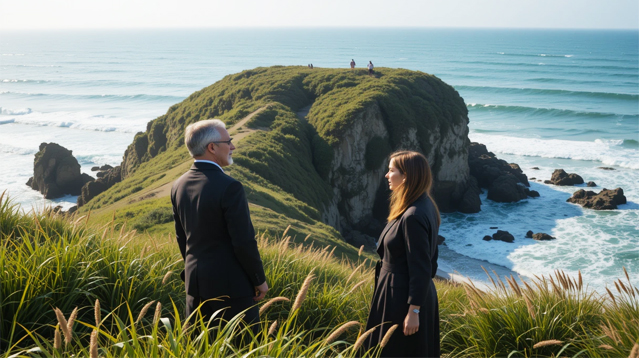EXOTIC with green reeds overlay—The afternoon sun gently embraces Cape Dancer, bathing the expanse of waving grass like golden waves. The sea breeze brings with it the scent of salt and the soft touch of frangipani flowers growing on the edge of the cliff. In the midst of the beautiful sunset, Professor Arya, with his silver hair blowing in the wind, stands beside Maya, a young botanist with eyes full of enthusiasm. Behind them, several tourists seem busy immortalizing themselves against the backdrop of the sparkling grass.
“Isn’t it beautiful, Professor?” said Maya, pointing to a fisherman who seemed to be pulling her fishing rod with a wide smile. “The potential of this village is extraordinary. Not only is the grass unique, the seafood is also abundant.”
Professor Arya nodded, his eyes narrowed at the horizon. “In the past, this cape was only known as a place for local residents to catch fish. The grass was considered ordinary. Who would have thought that it would become the main attraction now?”
“That’s the magic of perspective, Professor,” replied Maya with a smile. “In the past, people only saw the weeds as wild plants. Now, with the right touch of promotion, these weeds have become a stunning ‘golden carpet’ for taking pictures.”
A few months earlier, Coastal Dancer Village was just a quiet fishing village, almost forgotten by the hustle and bustle of Bali tourism. However, everything changed when a research team from Semesta University, led by Professors Arya and Maya, conducted a study on coastal biodiversity. They discovered the uniqueness of Cape Dancer, especially its vast expanse of weeds that change color dramatically at sunrise and sunset.
Maya, with her expertise in social media and digital marketing, saw the hidden tourism potential. She uploaded photos of Cape Dancer with interesting captions, highlighting the beauty of the twilight weeds, the quiet fishing spots, and the simple food stalls serving fresh seafood.
Initially, only a few local tourists were interested. However, through word of mouth and the viral photos on social media, Cape Dancer began to be visited by many people. People come to hunt for selfies with the unique background of the reeds, experience the sensation of fishing in calm waters, and enjoy delicious grilled seafood at affordable prices.
“Remember, Professor, when we first proposed this idea to the village head?” Maya asked with a chuckle. “He was hesitant. He said, ‘Reed is going to be a tourist spot? Is that wrong?’ But look at now.”
Professor Arya smiled. “Mr. Made is indeed a cautious person. But he is also wise and willing to listen. When we showed him data on the economic potential and its positive impact on the community, he finally agreed.”
Now, the village has undergone significant changes. Several local residents have opened fishing equipment rentals, small tourist boats, and beautified their food stalls. Young people who used to migrate to the city are now starting to return to develop the tourism potential in their village.
Suddenly, a tourist approached them. The middle-aged woman with a camera in her hand smiled friendly. “Excuse me, are you part of the management of this place?”
“Yes, ma’am,” Maya answered politely. “Can we help you?”
“This place is amazingly beautiful! I have never seen such beautiful grass. The photos will be great. And I tried the grilled fish at a nearby stall, it was so fresh. My husband also really enjoyed fishing at the tip of the cape.”
“Thank you very much, Ma’am. We are glad you enjoyed your visit,” Maya replied.
After the tourist left, Professor Arya looked at Maya proudly. “You really have an amazing vision, Maya. You see not only the grass, but also the economic and social potential for the people of this village.”
“It’s not just about the grass, Professor,” Maya said. “It’s about empowering the local people, introducing the untouched natural beauty of Bali, and combining it with local wisdom. We don’t want this village to become like other mass tourism destinations. We want to maintain its authenticity and serenity.”
“I agree,” Professor Arya added. “We need to work together with the local government and the community to ensure that tourism development here is sustainable. We need to educate them about the importance of maintaining cleanliness, preserving the environment, and respecting local culture.”
As dusk deepens, small lights begin to light up along the path leading to the cape. The aroma of grilled fish becomes more tempting. Several tourists are seen sitting relaxed on the edge of the cliff, enjoying their food while watching the sky change color to orange and purple.
“Look, Professor,” Maya whispered, pointing to a group of young people who were laughing happily while taking *selfies* with the background of the reeds lit by the moonlight. “They are the next generation of this village. Tourism sustainable development will give them hope and a better future.”
Professor Arya nodded in agreement. “Cape Twilight Reeds… a beautiful name. Hopefully, its beauty will continue to captivate the hearts of many people, and bring prosperity to Coastal Dancer Village.” They both fell silent for a moment, enjoying the beauty of the quiet night, accompanied by the crashing waves and the whispers of the wind among the waving grass, silent witnesses to the changes that bring hope to a village on the edge of Bali. (*)









